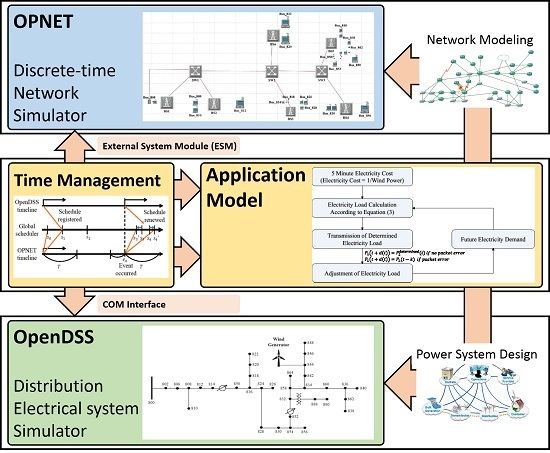CoSimulating Communication Networks and Electrical System for Performance Evaluation in Smart Grid
Abstract
1. Introduction
2. Related Work
3. OOCoSim Design and Implementation
3.1. OPNET and OpenDSS
3.2. OOCoSim Design
- The OPNET must advance its time after all of the OpenDSS events that could occur in that time are probed.
- The OpenDSS results must be registered before OPNET advances its time.
3.3. OOCoSim Architecture and Implementation
- First, OPNET simulation is invoked by the CoSim module through the functions defined in ESA, such as Esa_Main(), Esa_Init() and Esa_Load().
- Second, message communications of the application model are defined and performed by ESM. The protocol can be implemented with a finite state machine.
- Third, the required information, such as response time and packet error, is reported to the CoSim module through the function of ESM - op_esys_interface_value_set() with the defined data type.
- Fourth, the information is retrieved by the CoSim module through the callback handler which is defined for each EI. The information is passed to the application module.
- The CoSim module can execute OPNET simulation until the specific simulation time through the function Esa_Execute_Until().
- When an event occurs in OPNET simulation , the CoSim module can interrupt OPNET simulation by using the function Esa_Interrupt().
- When CoSim module receives information targeting ESM by OpenDSS or the application model, it delivers information with/without an interrupt through the functions defined in ESA such as Esa_Interface_Value_Set() and Esa_Interface_Array_Set().
4. Modeling of Smart Grid Application
5. Simulation Study
5.1. Simulation Model
- The gateway energy management system is a wlan_server or ethernet_server node model in OPNET.
- The energy management system model is a node model which includes the ESM process, and each ESM process reports the response time of application traffic to the CoSim module;
- The communications between the gateway system and each energy management system are configured with a server/client model.
5.2. Simulation Results
- OOCoSim creates events for the wind generator according to the pre-defined wind generator profile.
- The CoSim module calculates the load based on the forecasted 5 min electricity cost information.
- Every second, OOCoSim makes message communications through OPNET simulation and receives the response time information of each bus.
- Based on the calculated load and the response time information, CoSim module creates new events for OpenDSS simulation and assigns them to the global scheduler.
- When the scheduler encounters OpenDSS event, it applies the event to OpenDSS.
- After each event is applied to OpenDSS, OOCoSim dispatches the distribution system information—the total power loss and voltage.
5.3. Discussions on Simulation Scalability and Stability
6. Conclusions and Future Work
Acknowledgments
Author Contributions
Conflicts of Interest
References
- Albano, M.; Ferreira, L.L.; Pinho, L.M. Convergence of smart grid ict architectures for the last mile. IEEE Trans. Ind. Inf. 2015, 11, 187–197. [Google Scholar] [CrossRef]
- Bae, M.; Kim, K.; Kim, H. Preserving privacy and efficiency in data communication and aggregation for ami network. J. Netw. Comput. Appl. 2016, 59, 333–344. [Google Scholar] [CrossRef]
- Son, H.; Kang, T.Y.; Kim, H.; Roh, J.H. A secure framework for protecting customer collaboration in intelligent power grids. IEEE Trans. Smart Grid. 2011, 2, 759–769. [Google Scholar] [CrossRef]
- Kim, K.; Kim, H.; Jung, J.; Kim, H. Afar: A robust and delay-constrained communication framework for smart grid applications. Comput. Netw. 2015, 91, 1–25. [Google Scholar] [CrossRef]
- Anderson, K.; Du, J.; Narayan, A.; El Gamal, A. Gridspice: A distributed simulation platform for the smart grid. IEEE Trans. Ind. Inf. 2014, 10, 2354–2363. [Google Scholar] [CrossRef]
- Locke, G.; Gallagher, P.D. Nist Framework and Roadmap for Smart Grid Interoperability Standards, Release 3.0; National Institute of Standards and Technology: Gaithersburg, MD, USA, 2014. [Google Scholar]
- Parikh, P.P.; Kanabar, M.G.; Sidhu, T.S. Opportunities and challenges of wireless communication technologies for smart grid applications. In Proceedings of the 2010 IEEE Power and Energy Society General Meeting, Providence, RI, USA, 25–29 July 2010. [Google Scholar]
- Sadi, M.A.H.; Ali, M.H.; Dasgupta, D.; Abercrombie, R.K. Opnet/simulink based testbed for disturbance detection in the smart grid. In Proceedings of the 10th Annual Cyber and Information Security Research Conference, Oak Ridge, TN, USA, 7–9 April 2015. [Google Scholar]
- Sarena, S.T. A Framework for Microgrid Analysis Using OpenDSS; LAP LAMBERT Academic Publishing: Saarbrücken, Germany, 2014. [Google Scholar]
- Hopkinson, K.; Wang, X.; Giovanini, R.; Thorp, J.; Birman, K.; Coury, D. Epochs: A platform for agent-based electric power and communication simulation built from commercial off-the-shelf components. IEEE Trans. Power Syst. 2006, 21, 548–558. [Google Scholar] [CrossRef]
- Lin, H.; Veda, S.S.; Shukla, S.S.; Mili, L.; Thorp, J. Geco: Global event-driven co-simulation framework for interconnected power system and communication network. IEEE Trans. Smart Grid 2012, 3, 1444–1456. [Google Scholar] [CrossRef]
- Kilic, N.; Gungor, V.C. Analysis of low power wireless links in smart grid environments. Comput. Netw. 2013, 57, 1192–1203. [Google Scholar] [CrossRef]
- Karimi, B.; Namboodiri, V.; Aravinthan, V.; Jewell, W. Feasibility, challenges, and performance of wireless multi-hop routing for feeder level communication in a smart grid. In Proceedings of the 2nd International Conference on Energy-Efficient Computing and Networking, New York, NY, USA, 31 May–1 June 2011; pp. 31–40. [Google Scholar]
- Karnouskos, S.; De Holanda, T.N. Simulation of a smart grid city with software agents. In Proceedings of the Third UKSim European Symposium on Computer Modeling and Simulation, Athens, Greece, 25–27 November 2009; pp. 424–429. [Google Scholar]
- Godfrey, T.; Mullen, S.; Dugan, R.; Rodine, C.; Griffith, D.; Golmie, N. Modeling smart grid applications with co-simulation. In Proceedings of the 2010 First IEEE International Conference on Smart Grid Communications, Gaithersburg, MD, USA, 4–6 October 2010; pp. 291–296. [Google Scholar]
- Lin, H.; Sambamoorthy, S.; Shukla, S.; Thorp, J.; Mili, L. Power system and communication network co-simulation for smart grid applications. In Proceedings of the 2011 IEEE PES Innovative Smart Grid Technologies (ISGT), Anaheim, CA, USA, 17–19 January 2011; pp. 1–6. [Google Scholar]
- Bhor, D.; Angappan, K.; Sivalingam, K.M. Network and power-grid co-simulation framework for smart grid wide-area monitoring networks. J. Netw. Comput. Appl. 2016, 59, 274–284. [Google Scholar] [CrossRef]
- Mets, K.; Verschueren, T.; Develder, C.; Vandoorn, T.L.; Vandevelde, L. Integrated simulation of power and communication networks for smart grid applications. In Proceedings of the 2011 IEEE 16th International Workshop on Computer Aided Modeling and Design of Communication Links and Networks (CAMAD), Kyoto, Japan, 10–11 June 2011; pp. 61–65. [Google Scholar]
- Tong, X. The co-simulation extending for wide-area communication networks in power system. In Proceedings of the 2010 Asia-Pacific Power and Energy Engineering Conference (APPEEC), Chengdu, China, 28–31 March 2010. [Google Scholar]
- Mallouhi, M.; Al-Nashif, Y.; Cox, D.; Chadaga, T.; Hariri, S. A testbed for analyzing security of scada control systems (tasscs). In Proceedings of the 2011 IEEE PES Innovative Smart Grid Technologies (ISGT), Anaheim, CA, USA, 17–19 January 2011. [Google Scholar]
- Sun, X.; Chen, Y.; Liu, J.; Huang, S. A co-simulation platform for smart grid considering interaction between information and power systems. In Proceedings of the 2014 IEEE PES Innovative Smart Grid Technologies Conference (ISGT), Washington, DC, USA, 19–22 February 2014. [Google Scholar]
- Dugan, R.C. OpenDSS Reference Guide; Electric Power Research Institute, Inc.: Palo Alto, CA, USA, 2012. [Google Scholar]
- Microsoft MSDN. Available online: http://msdn.microsoft.com/en-us/library/ms680573 (accessed on 8 January 2018).
- Hamida, E.B.; Chelius, G.; Gorce, J.-M. Impact of the physical layer modeling on the accuracy and scalability of wireless network simulation. Simulation 2009, 85, 574–588. [Google Scholar] [CrossRef]
- Dricot, J.-M.; Doncker, P.D. High-accuracy physical layer model for wireless network simulations in ns-2. In Proceedings of the IWAN’04–International Workshop on Wireless Ad-hoc Networks, Oulu, Finland, 31 May–3 June 2004. [Google Scholar]
- Montenegro, D.; Hernandez, M.; Ramos, G. Real time opendss framework for distribution systems simulation and analysis. In Proceedings of the 2012 Sixth IEEE/PES on Transmission and Distribution: Latin America Conference and Exposition (T&D-LA), Montevideo, Uruguay, 3–5 September 2012. [Google Scholar]
- Li, W.; Ferdowsi, M.; Stevic, M.; Monti, A.; Ponci, F. Cosimulation for smart grid communications. IEEE Trans. Ind. Inf. 2014, 10, 2374–2384. [Google Scholar] [CrossRef]
- Chen, L.; Wu, Z.; Fu, Y. Real-time price-based demand response management for residential appliances via stochastic optimization and robust optimization. IEEE Trans. Smart Grid 2012, 3, 1822–1831. [Google Scholar] [CrossRef]
- Anwar, A.; Pota, H. Loss reduction of power distribution network using optimum size and location of distributed generation. In Proceedings of the 2011 21st Australasian Universities Power Engineering Conference (AUPEC), Brisbane, Australia, 25–28 September 2011. [Google Scholar]
- Lamaina, P.; Sarno, D.; Siano, P.; Zakariazadeh, A.; Romano, R. A model for wind turbines placement within a distribution network acquisition market. IEEE Trans. Ind. Inf. 2015, 11, 210–219. [Google Scholar] [CrossRef]
- O’Donnell, J. Voltage Management of Networks With Distributed Generation. Ph.D. Thesis, The University of Edinburgh, 2008. Available online: http://hdl.handle.net/1842/2577 (accessed on 8 January 2018).
- Korea Meteorological Administration. Automatic Weather Station. 2013. Available online: http://www.kma.go.kr/weather/observation/currentweather.jsp (accessed on 8 January 2018).
- Kersting, W.H. Radial distribution test feeders. In Proceedings of the 2001 IEEE Power Engineering Society Winter Meeting, Columbus, OH, USA, 28 January–1 February 2001; Volume 2, pp. 908–912. [Google Scholar]
- SIMENS. Automated Demand Response Using OpenADR Application Guide, 3rd ed.; SIMENS: Berlin/Munich, Germany, 2011. [Google Scholar]
- Taylor, J.W. An evaluation of methods for very short-term load forecasting using minute-by-minute british data. Int. J. Forecast. 2008, 24, 645–658. [Google Scholar] [CrossRef]
- Makonin, S. The Almanac of Minutely Power Dataset. 2013. Available online: http://ampds.org/ (accessed on 8 January 2018).
- Fujimoto, R.M.; Perumalla, K.; Park, A.; Wu, H.; Ammar, M.H.; Riley, G.F. Large-scale network simulation: How big? how fast? In Proceedings of the 11th IEEE/ACM International Symposium on Modeling, Analysis and Simulation of Computer Telecommunications Systems (MASCOTS), Orlando, FL, USA, 12–15 October 2003; pp. 116–123. [Google Scholar]
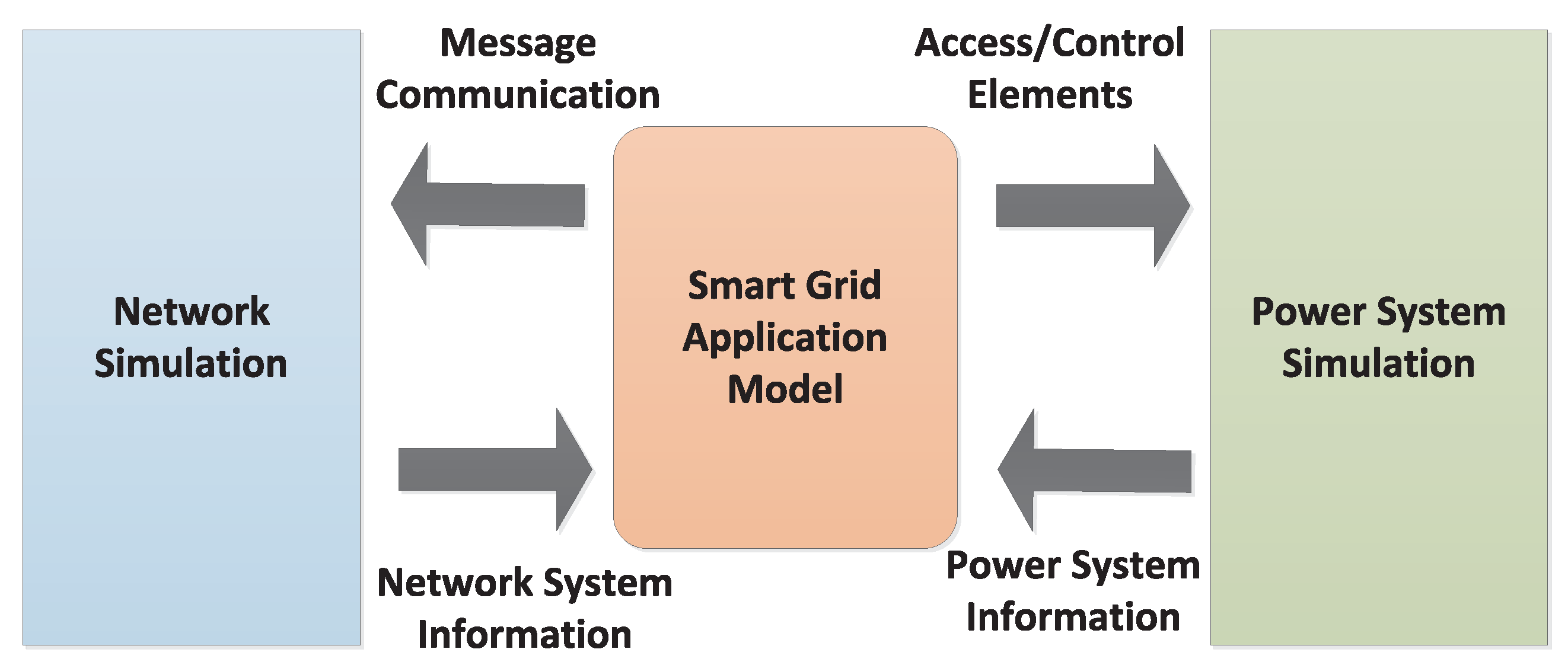
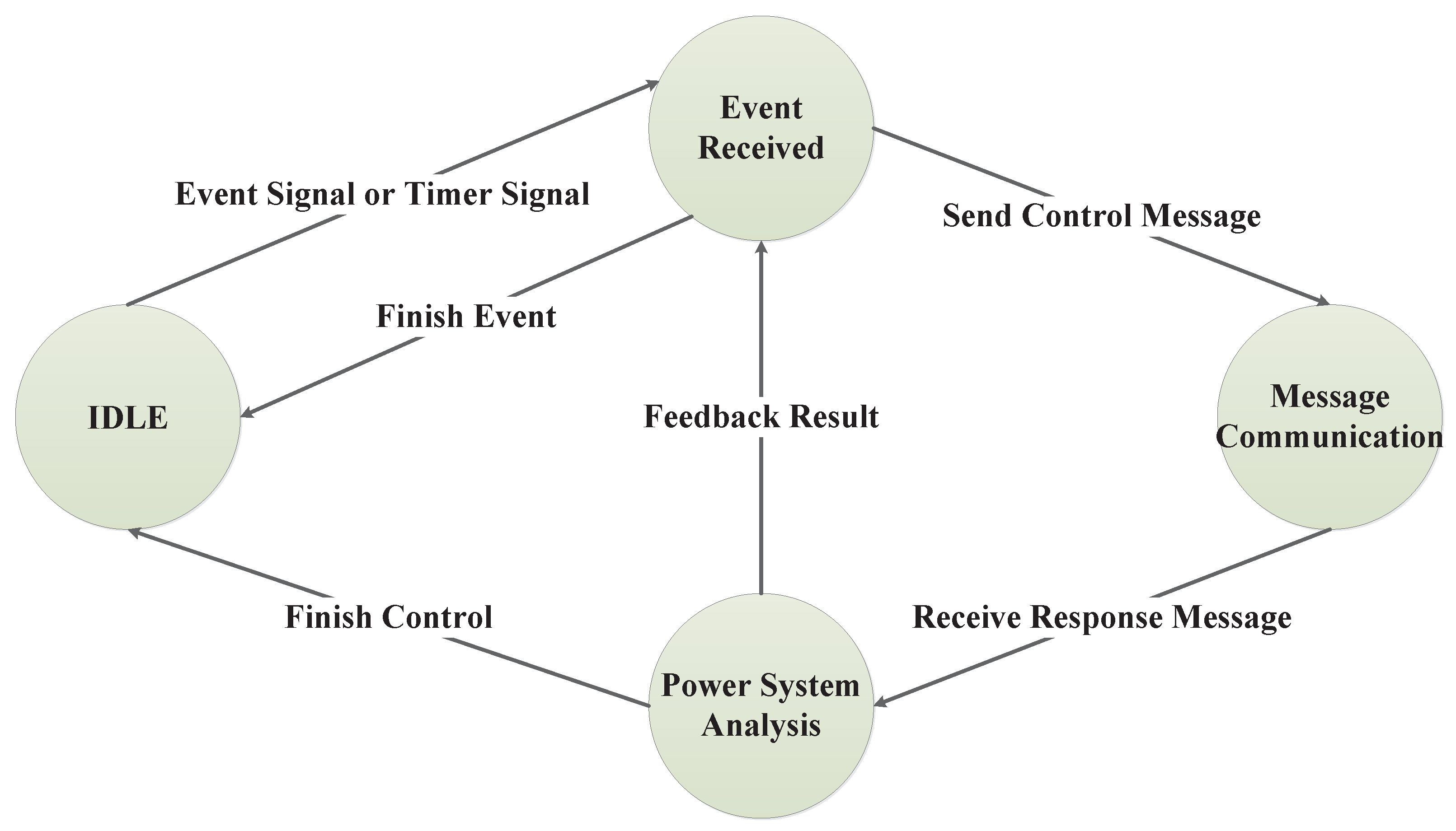
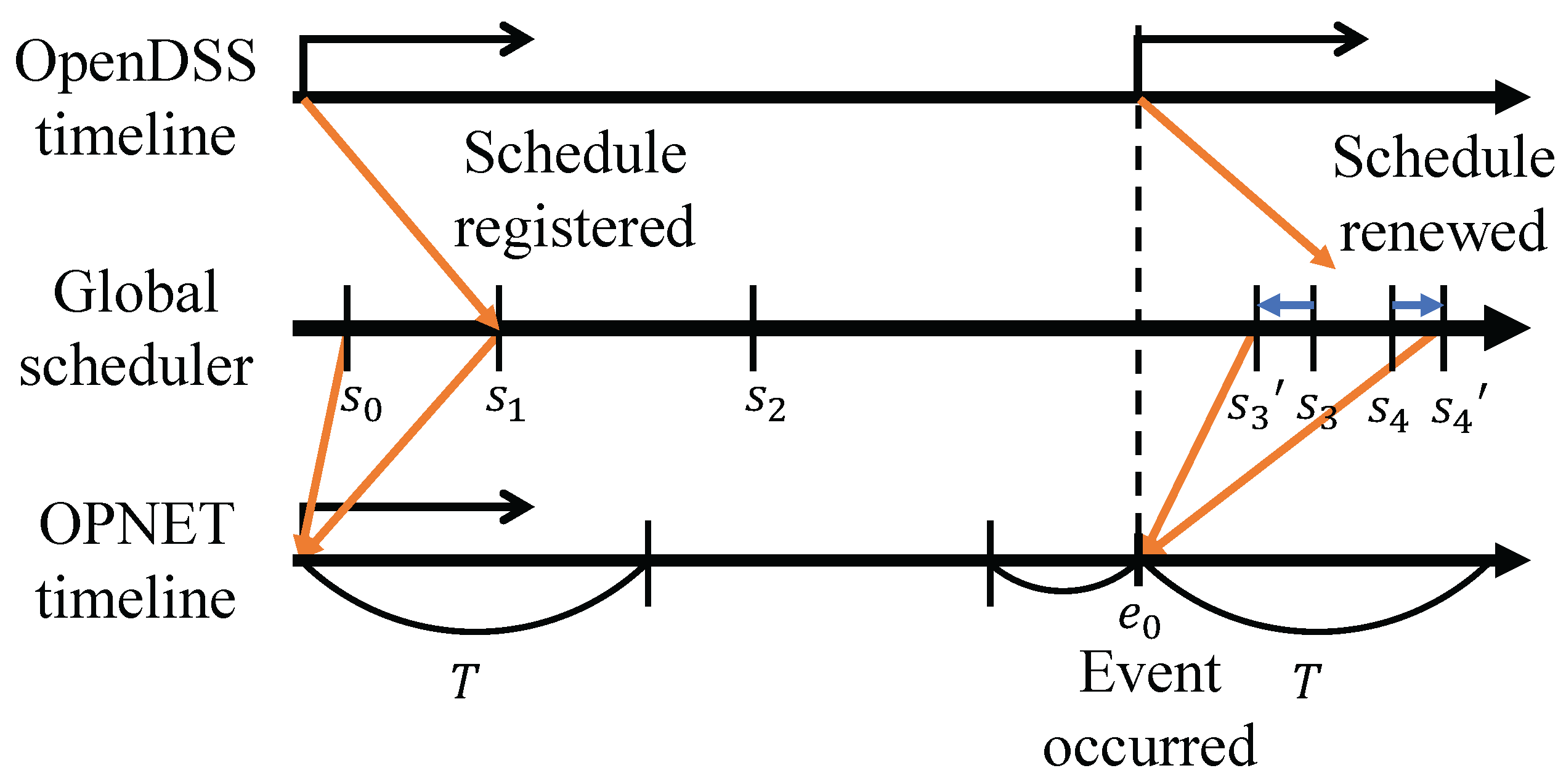
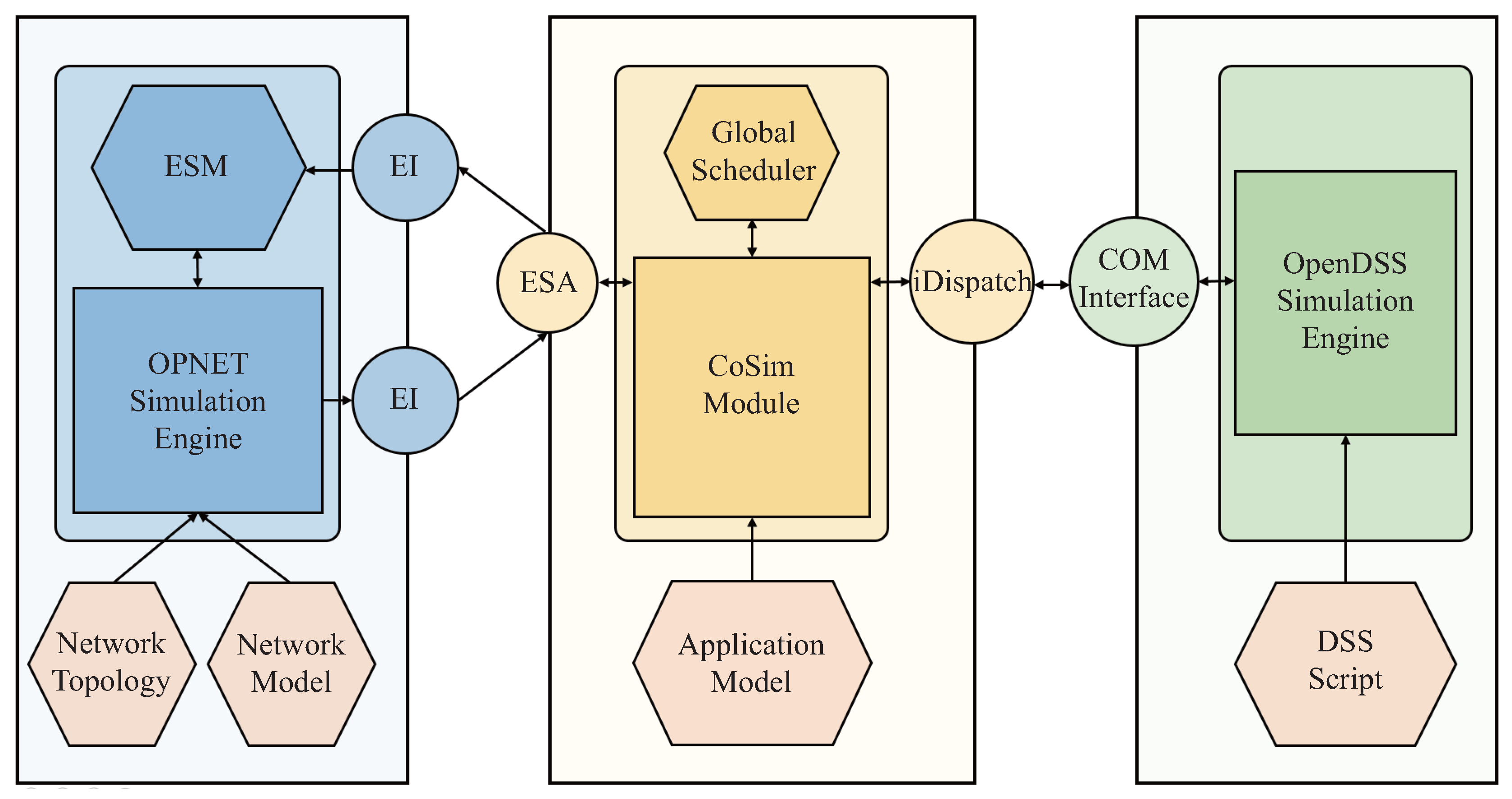

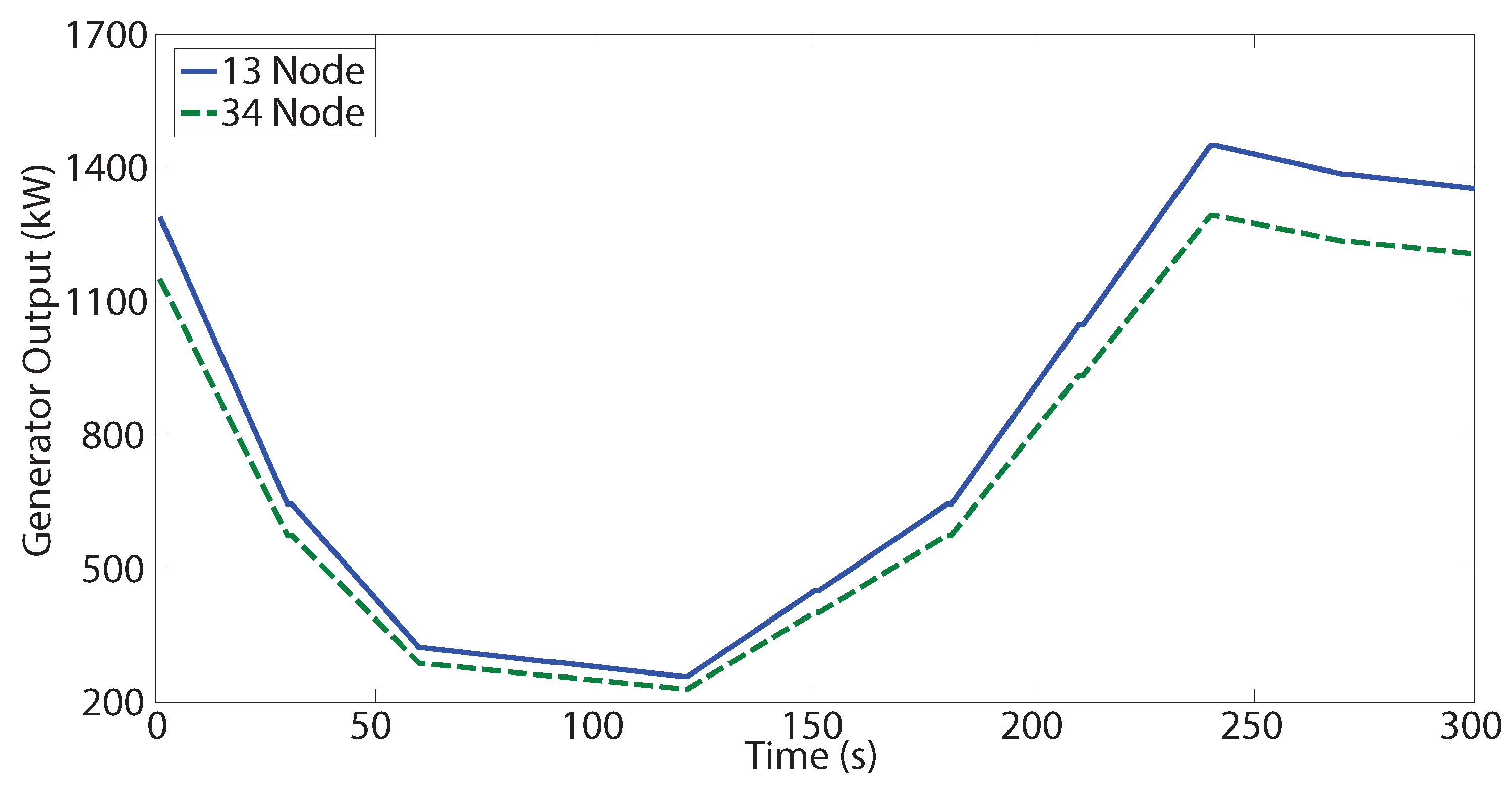
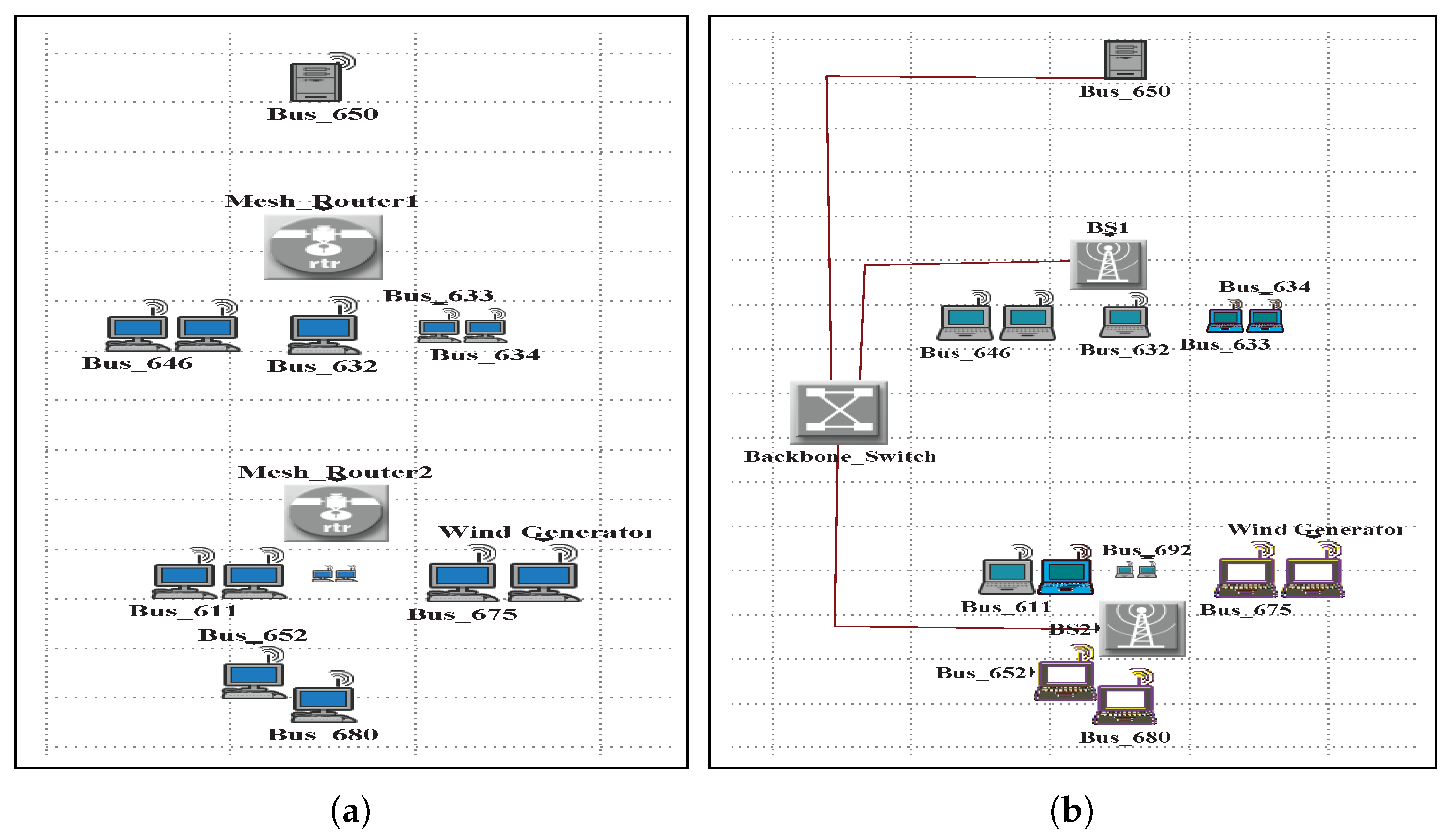
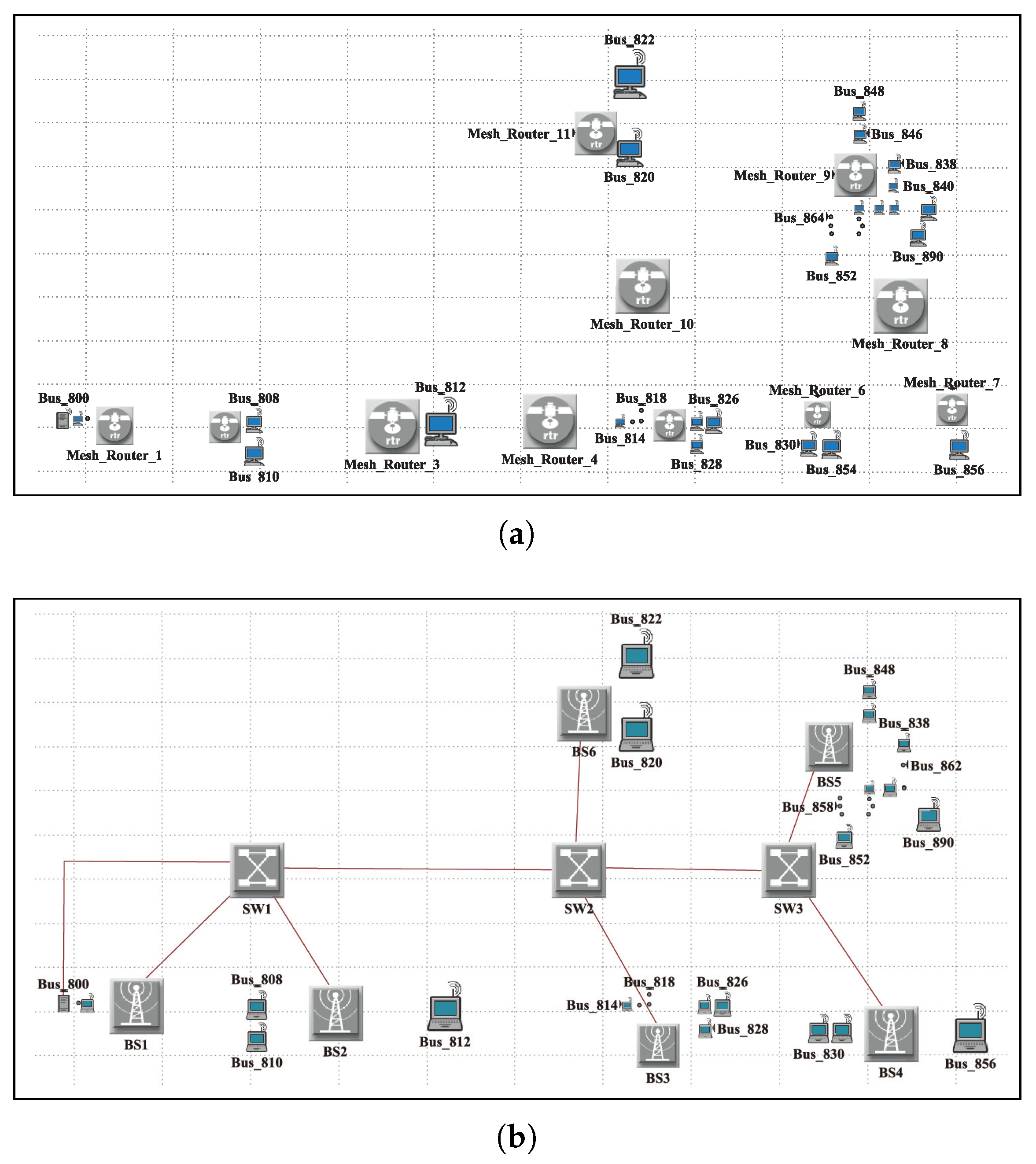
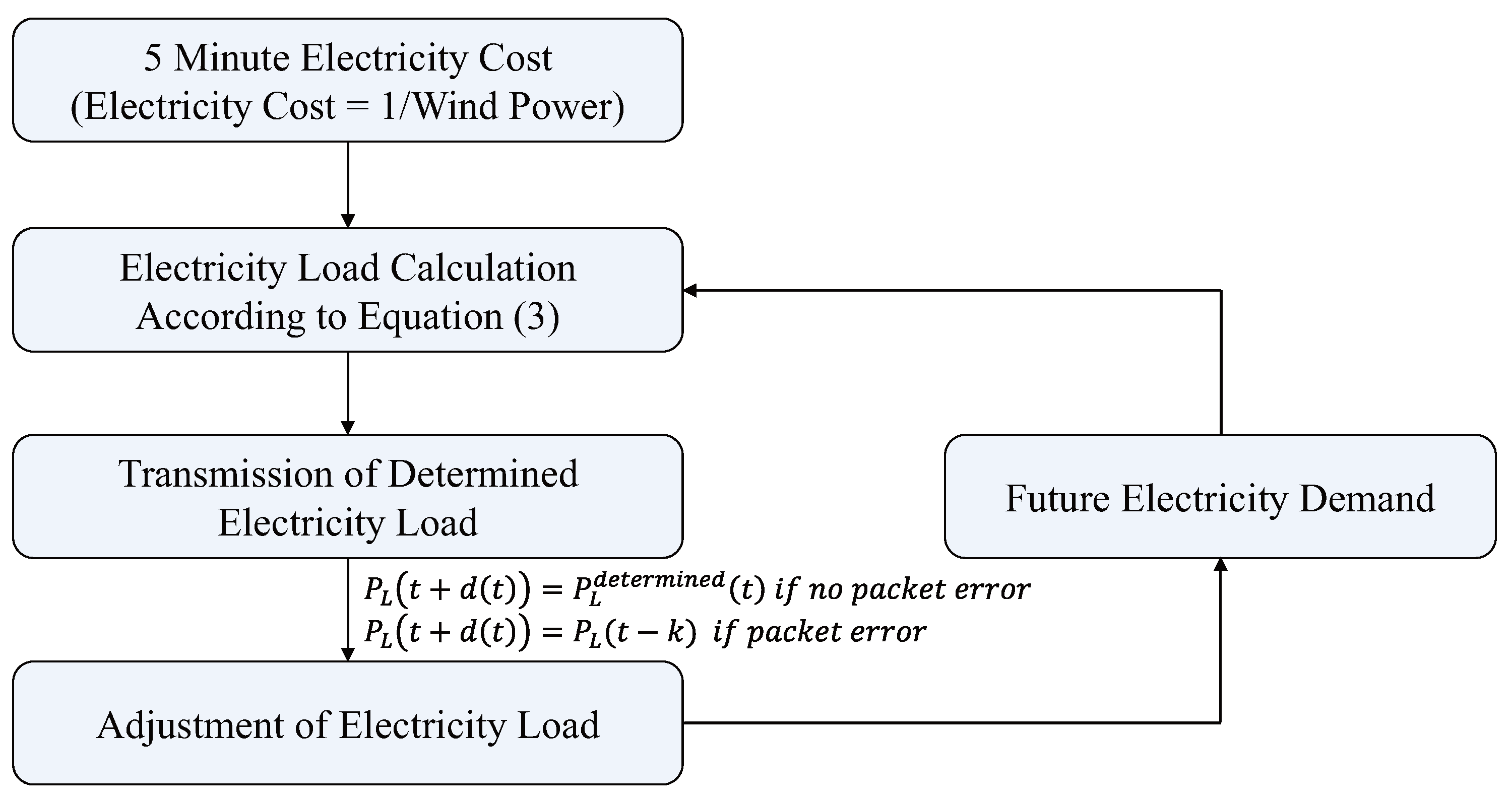
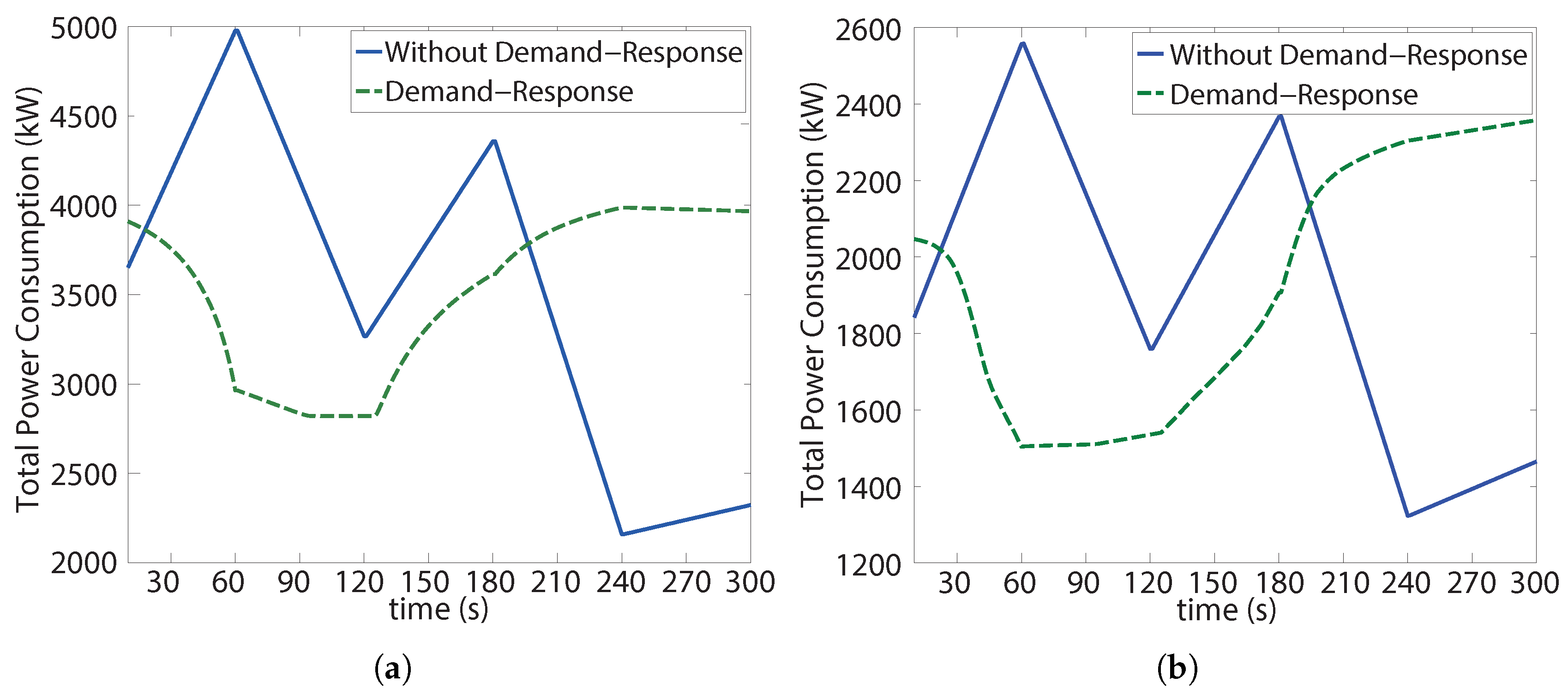
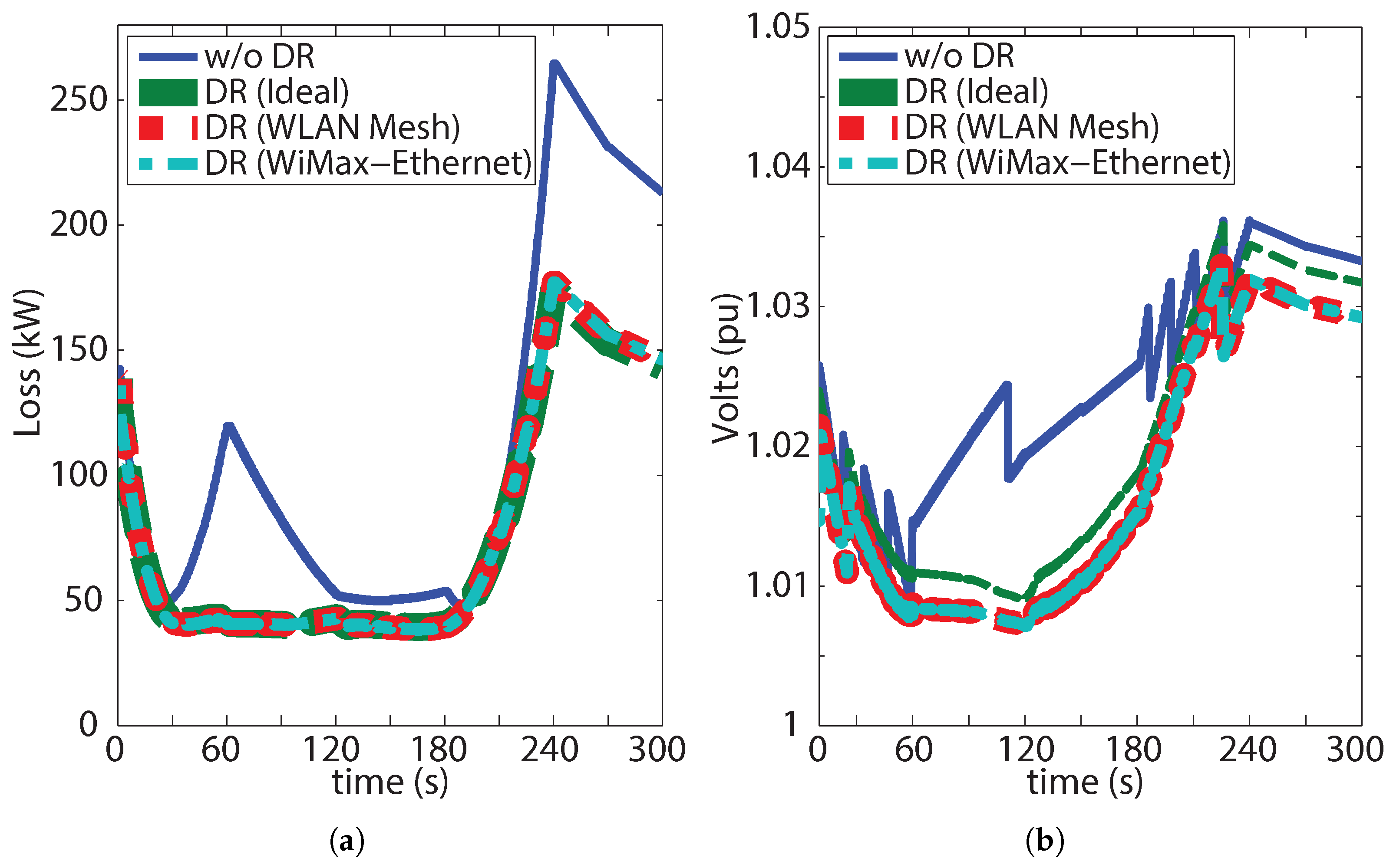

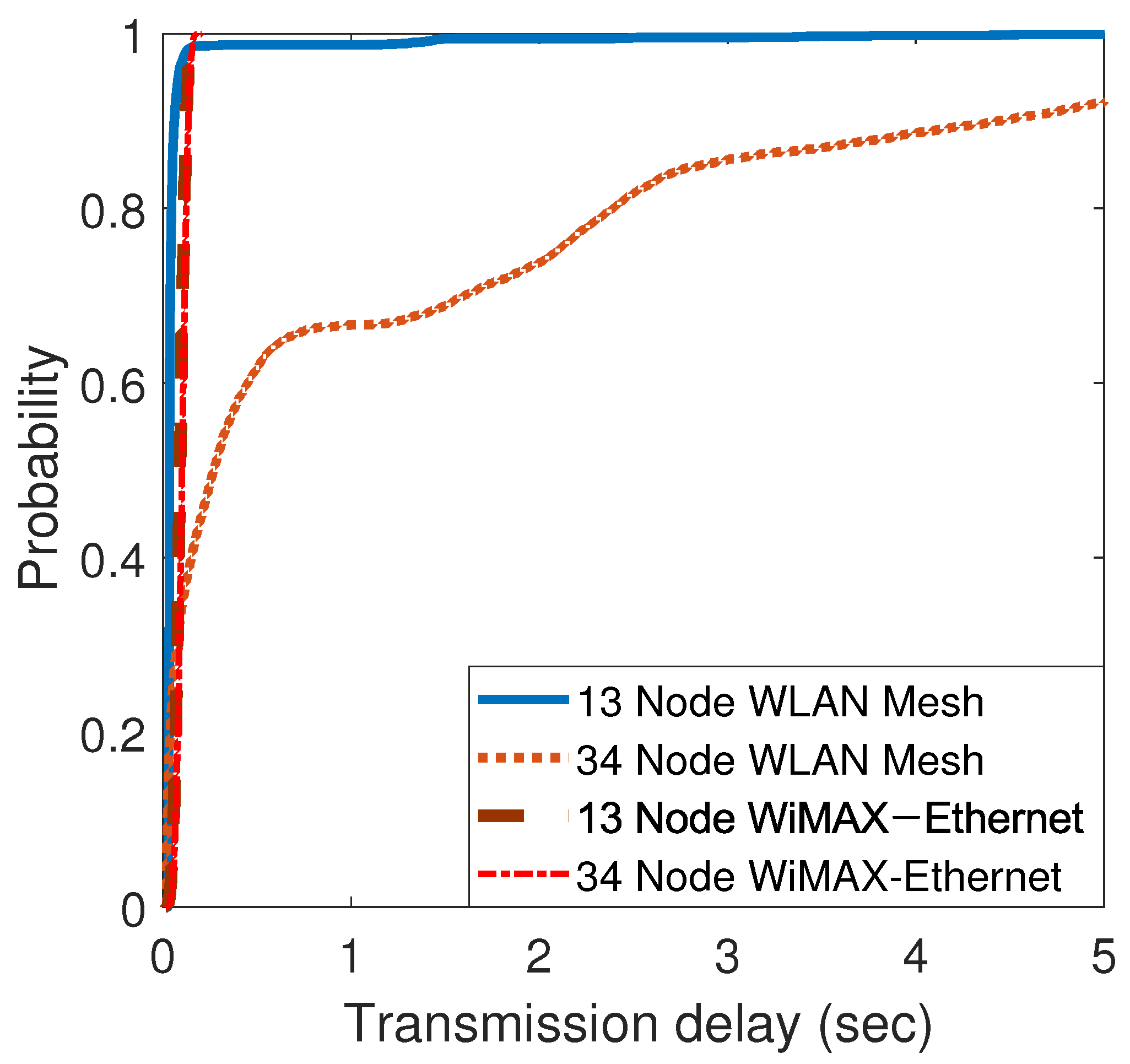
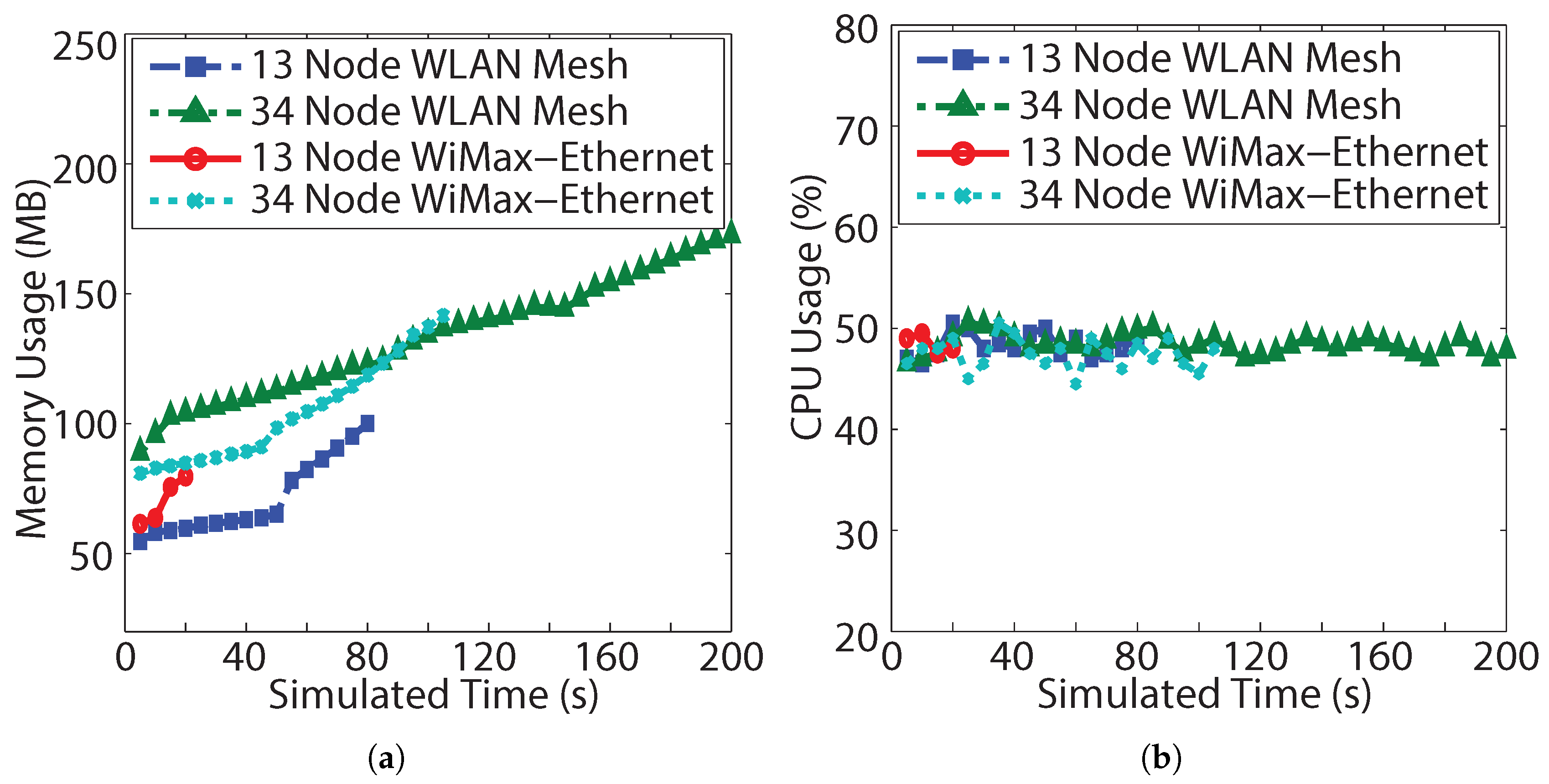

| 13 Node System | 34 Node System | |
|---|---|---|
| w/o DR | 679.272 | 362.568 |
| DR | 579.617 | 308.449 |
| Saving | 14.7% | 14.9% |
| Total Power Loss | Voltage Index | |
|---|---|---|
| w/o DR | 33,385 kW | 0.1533 |
| DR (Ideal) | 22,795 kW | 0.0741 |
| DR (WLAN Mesh) | 23,125 kW | 0.0783 |
| DR (WiMax-Ethernet) | 23,094 kW | 0.0825 |
| Total Power Loss | Voltage Index | |
|---|---|---|
| w/o DR | 136,180 kW | 0.4156 |
| DR (Ideal) | 94,545 kW | 0.2686 |
| DR (WLAN Mesh) | 119,340 kW | 0.6101 |
| DR (WiMax-Ethernet) | 95,412 kW | 0.2735 |
| 13 Node WLAN Mesh | 34 Node WLAN Mesh | 13 Node WiMax-Ether | 34 Node WiMax-Ether | |
|---|---|---|---|---|
| OPNET execution time | 75.4 s | 568.4 s | 12.7 s | 57.3 s |
| # of OPNET events | 15,520,756 | 136,464,504 | 2,563,603 | 10,880,800 |
| OpenDSS execution time | 6.2 s | 38.7 s | 6.3 s | 43.7 s |
| # of OpenDSS events | 3764 | 16,497 | 3900 | 20,700 |
| Total execution time | 81.6 s | 607.1 s | 19.0 s | 101.0 s |
© 2018 by the authors. Licensee MDPI, Basel, Switzerland. This article is an open access article distributed under the terms and conditions of the Creative Commons Attribution (CC BY) license (http://creativecommons.org/licenses/by/4.0/).
Share and Cite
Kim, H.; Kim, K.; Park, S.; Kim, H.; Kim, H. CoSimulating Communication Networks and Electrical System for Performance Evaluation in Smart Grid. Appl. Sci. 2018, 8, 85. https://doi.org/10.3390/app8010085
Kim H, Kim K, Park S, Kim H, Kim H. CoSimulating Communication Networks and Electrical System for Performance Evaluation in Smart Grid. Applied Sciences. 2018; 8(1):85. https://doi.org/10.3390/app8010085
Chicago/Turabian StyleKim, Hwantae, Kangho Kim, Seongjoon Park, Hyunsoon Kim, and Hwangnam Kim. 2018. "CoSimulating Communication Networks and Electrical System for Performance Evaluation in Smart Grid" Applied Sciences 8, no. 1: 85. https://doi.org/10.3390/app8010085
APA StyleKim, H., Kim, K., Park, S., Kim, H., & Kim, H. (2018). CoSimulating Communication Networks and Electrical System for Performance Evaluation in Smart Grid. Applied Sciences, 8(1), 85. https://doi.org/10.3390/app8010085





